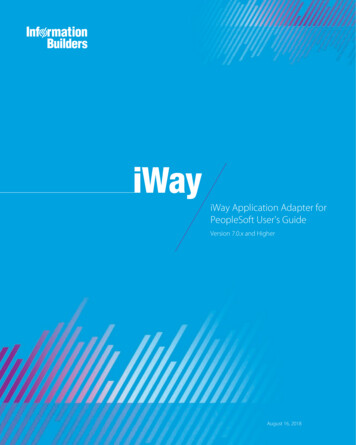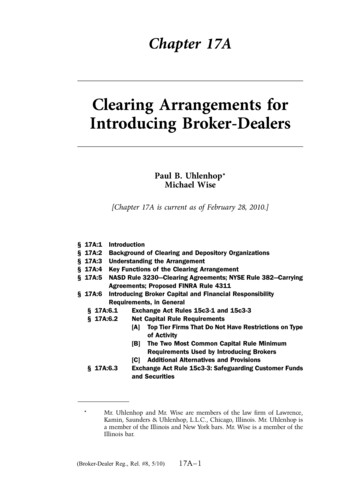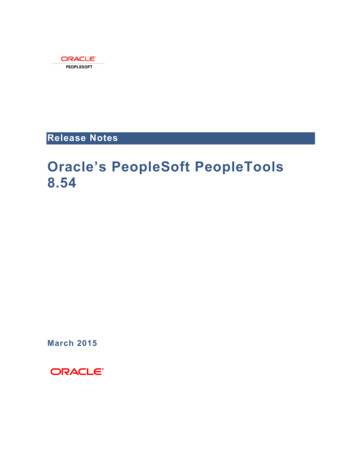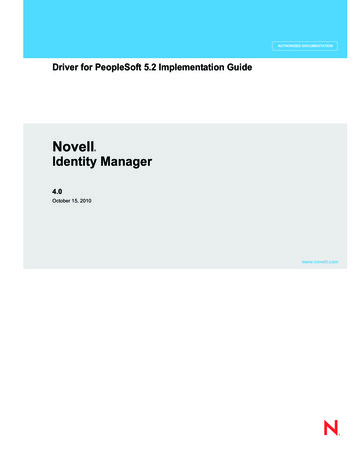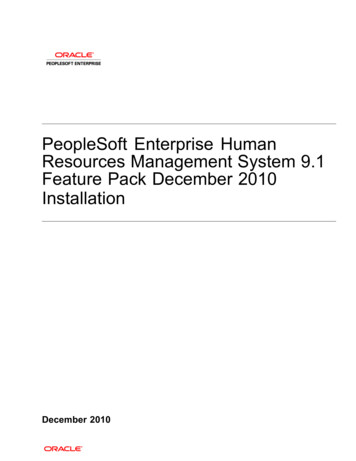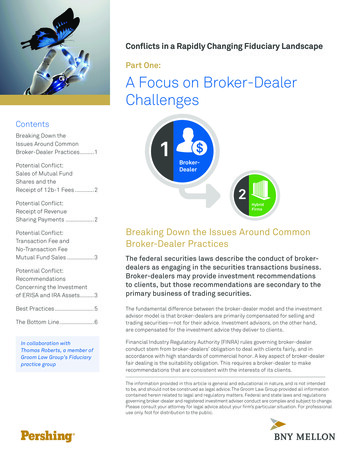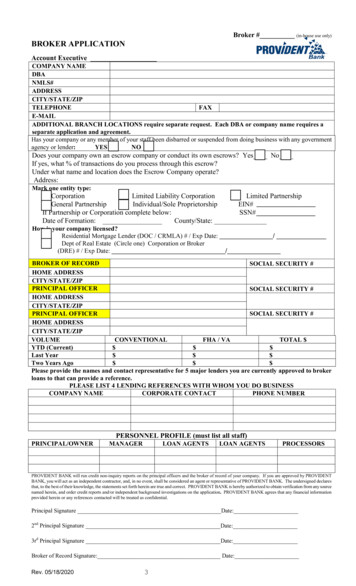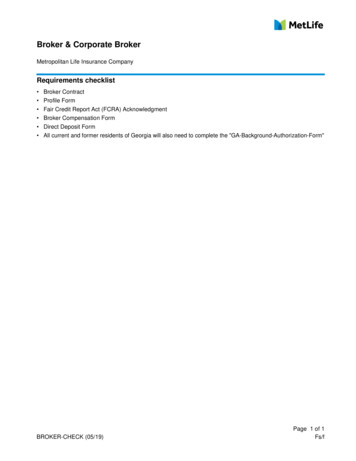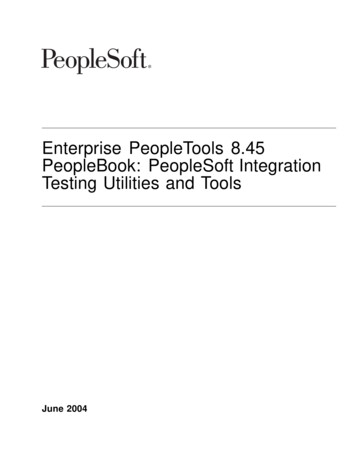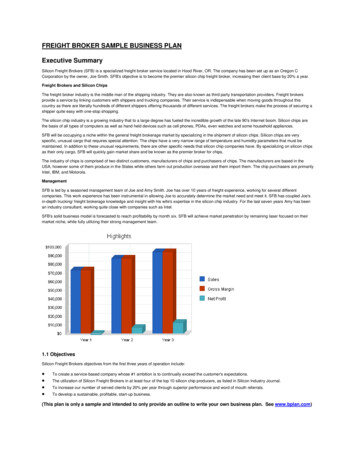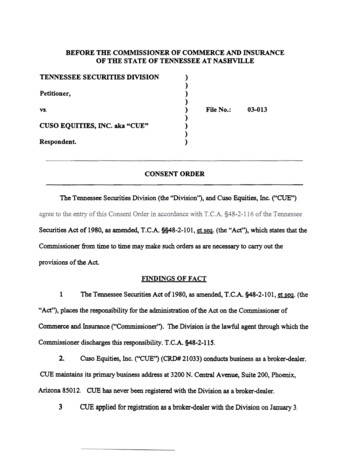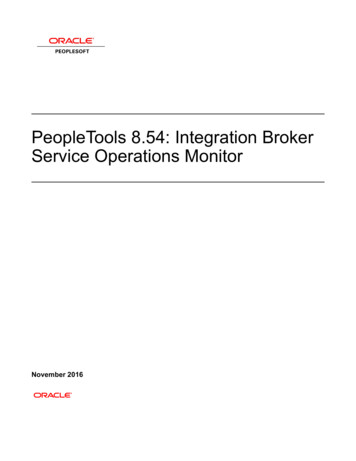
Transcription
PeopleTools 8.54: Integration BrokerService Operations MonitorNovember 2016
PeopleTools 8.54: Integration Broker Service Operations MonitorCDSKUCopyright 1988, 2016, Oracle and/or its affiliates. All rights reserved.License Restrictions Warranty/Consequential Damages DisclaimerThis software and related documentation are provided under a license agreement containing restrictionson use and disclosure and are protected by intellectual property laws. Except as expressly permittedin your license agreement or allowed by law, you may not use, copy, reproduce, translate, broadcast,modify, license, transmit, distribute, exhibit, perform, publish, or display any part, in any form, or by anymeans. Reverse engineering, disassembly, or decompilation of this software, unless required by law forinteroperability, is prohibited.Warranty DisclaimerThe information contained herein is subject to change without notice and is not warranted to be error-free.If you find any errors, please report them to us in writing.Restricted Rights NoticeIf this is software or related documentation that is delivered to the U.S. Government or anyone licensing iton behalf of the U.S. Government, then the following notice is applicable:U.S. GOVERNMENT END USERS: Oracle programs, including any operating system, integratedsoftware, any programs installed on the hardware, and/or documentation, delivered to U.S. Governmentend users are "commercial computer software" pursuant to the applicable Federal Acquisition Regulationand agency-specific supplemental regulations. As such, use, duplication, disclosure, modification,and adaptation of the programs, including any operating system, integrated software, any programsinstalled on the hardware, and/or documentation, shall be subject to license terms and license restrictionsapplicable to the programs. No other rights are granted to the U.S. Government.Hazardous Applications NoticeThis software or hardware is developed for general use in a variety of information managementapplications. It is not developed or intended for use in any inherently dangerous applications, includingapplications that may create a risk of personal injury. If you use this software or hardware in dangerousapplications, then you shall be responsible to take all appropriate fail-safe, backup, redundancy, andother measures to ensure its safe use. Oracle Corporation and its affiliates disclaim any liability for anydamages caused by use of this software or hardware in dangerous applications.Trademark NoticeOracle and Java are registered trademarks of Oracle and/or its affiliates. Other names may be trademarksof their respective owners.Intel and Intel Xeon are trademarks or registered trademarks of Intel Corporation. All SPARC trademarksare used under license and are trademarks or registered trademarks of SPARC International, Inc.AMD, Opteron, the AMD logo, and the AMD Opteron logo are trademarks or registered trademarks ofAdvanced Micro Devices. UNIX is a registered trademark of The Open Group.
Third Party Content, Products, and Services DisclaimerThis software or hardware and documentation may provide access to or information about content,products, and services from third parties. Oracle Corporation and its affiliates are not responsible for andexpressly disclaim all warranties of any kind with respect to third-party content, products, and servicesunless otherwise set forth in an applicable agreement between you and Oracle. Oracle Corporation and itsaffiliates will not be responsible for any loss, costs, or damages incurred due to your access to or use ofthird-party content, products, or services, except as set forth in an applicable agreement between you andOracle.Documentation AccessibilityFor information about Oracle's commitment to accessibility, visit the Oracle Accessibility Programwebsite at http://www.oracle.com/pls/topic/lookup?ctx acc&id docacc.Access to Oracle SupportOracle customers that have purchased support have access to electronic support through My OracleSupport. For information, visit http://www.oracle.com/pls/topic/lookup?ctx acc&id info or visit http://www.oracle.com/pls/topic/lookup?ctx acc&id trs if you are hearing impaired.
ContentsPreface.ixUnderstanding the PeopleSoft Online Help and PeopleBooks. ixPeopleSoft Hosted Documentation. ixLocally Installed Help. ixDownloadable PeopleBook PDF Files.ixCommon Help Documentation.xField and Control Definitions. xTypographical Conventions. xISO Country and Currency Codes. xiRegion and Industry Identifiers. xiUsing and Managing the PeopleSoft Online Help.xiiUnderstanding the Integration Broker Service Operations Monitor. xiiPeopleTools Related Links. xiiContact Us. xiiiFollow Us.xiiiChapter 1: Understanding the Integration Broker Service Operations Monitor.15Service Operations Monitor Features. 15Service Operations Monitor Components. 15Service Operations Monitor Security. 16Chapter 2: Filtering Service Operation Data. 17Filtering Service Operation Data.17Selecting Filtering Criteria.17Saving Filtering Selections. 17Chapter 3: Monitoring Asynchronous Service Operations. 19Understanding Asynchronous Service Operations Statuses. 19Processing Statuses for Asynchronous Service Operations. 19Asynchronous Service Operation Status of Done with Error Link Enabled.21Blocked Queues and Processing Statuses. 21Stalled Queues and Processing Statuses. 22Filtering Asynchronous Service Operation Data.22Viewing Monitor Output for Asynchronous Service Operation Data. 24Monitoring Asynchronous Service Operation Transactions.25Monitoring Asynchronous Service Operation Instances. 26Monitoring Publication Contracts.27Monitoring Subscription Contracts.28Viewing Queue Partitioning Information. 29Chapter 4: Viewing Asynchronous Service Operation Details. 31Understanding Viewing Asynchronous Service Operation Details.31Common Elements Used to View Asynchronous Service Operation Details. 31Viewing Asynchronous Service Operation Instance Details. 33Viewing Asynchronous Publication Contracts Details.35Viewing and Working with Publication Actions. 35Viewing Publication Information Details.36Viewing Asynchronous Subscription Contracts Details.36Viewing and Working with Subscription Actions. 37Viewing and Working with Subscription Information. 37Setting the Data Length View Limit for Displaying XML. 38Copyright 1988, 2016, Oracle and/or its affiliates. All rights reserved.v
ContentsViewing Logical Transformation XML Output.38Chapter 5: Monitoring Synchronous Service Operations. 39Understanding Synchronous Service Operation Statuses.39Filtering Synchronous Service Operations Data. 39Viewing Monitor Output for Synchronous Service Operations Data.40Viewing Synchronous Service Operation Transaction Information.41Viewing Synchronous Service Operation General Information.42Chapter 6: Viewing Synchronous Service Operation Instance Details. 43Viewing Synchronous Service Operation Details. 43Chapter 7: Viewing Integration Gateway Logging Data for Service Operations. 47Viewing Integration Gateway Logging Data in the Service Operations Monitor. 47Understanding Viewing Integration Gateway Logging Data in the Service OperationsMonitor. 47Prerequisites for Viewing Integration Gateway Logging Data in the Service OperationsMonitor. 48Enabling Integration Gateway Message Logging in the Service Operations Monitor.48Changing the Storage Directory for Integration Gateway Transaction Logs.49Viewing Integration Gateway Logging Data for Service Operation Transactions.50Chapter 8: Resubmitting and Canceling Service Operations for Processing. 53Understanding Resubmitting and Canceling Service Operations for Processing. 53Understanding Resubmitting and Canceling Future-Dated Publications. 53Resubmitting and Canceling Individual Service Operations.53Resubmitting and Canceling Service Operations in Bulk. 53Chapter 9: Viewing Service Operation IB Info Data.55Viewing IB Info Data. 55Chapter 10: Viewing Service Operation Errors. 57Understanding Viewing Service Operation Errors. 57Common Elements Used to View Service Operation Errors. 57Viewing Asynchronous Service Operation Instance Errors. 58Viewing Asynchronous Publication Contract Errors.58Viewing Asynchronous Subscription Contract Errors.59Viewing Synchronous Service Operations Errors. 59Chapter 11: Viewing and Editing Service Operation XML. 61Understanding Viewing and Editing Service Operation XML.61Asynchronous Service Operation XML.61Synchronous Service Operation XML. 61Viewing Service Operation XML.62Editing Service Operation XML.63Chapter 12: Viewing Service Operation Nonrepudiation Signature Information. 65Understanding Viewing Service Operation Nonrepudiation Signature Information. 65Viewing Nonrepudiation Signatures in XML Format. 66Chapter 13: Running Batch Error Notification Processes. 67Understanding Batch Error Notification.67Prerequisites for Using Batch Error Notification. 68Creating Static Error Notification Lists.69Running Batch Error Notifications.70Chapter 14: Archiving Service Operation Instances. 73Understanding Archiving Service Operation Instances.73Archiving Service Operations.73Retrieving Archived Messages. 73Chapter 15: Running Batch Service Operation Archiving Processes. 75viCopyright 1988, 2016, Oracle and/or its affiliates. All rights reserved.
ContentsUnderstanding Running Batch Service Operation Archiving Processes. 75Prerequisites for Running Batch Service Operation Archiving Processes. 75Running Batch Service Operation Archiving Processes. 75Chapter 16: Viewing System Performance Statistics.79Understanding Messaging System Performance Statistics.79Service Operation Types. 79Processing Components.79Overhead Processing. 80Processing Times. 81Using the Statistics Pages.82Enabling the System Performance Statistics Feature. 87Searching for System Performance Statistics.88Common Elements Used to Search for System Performance Statistics. 88Searching for Performance Statistics. 88Viewing Messaging System Performance Statistics.89Common Elements Used to View Messaging System Performance Statistics. 89Viewing Inbound Asynchronous Statistics. 91Viewing Outbound Asynchronous Statistics.93Viewing Inbound Synchronous Service Operation Statistics.97Viewing Outbound Synchronous Statistics. 100Purging System Performance Statistics. 105Chapter 17: Managing Down Nodes.107Understanding Managing Down Nodes.107Viewing Transaction Information for Down Nodes. 107Clearing Transaction Data for System Node Restart. 108Chapter 18: Pausing, Testing, and Pinging Nodes. 109Understanding Pausing Nodes. 109Adding Pause Times to Local Nodes. 110Deleting Pause Times. 110Testing Local Nodes. 111Pinging Remote Nodes. 111Chapter 19: Pausing and Starting Queues.113Pausing Queues. 113Starting Queues. 114Chapter 20: Cleaning Up Orphaned Data From Segment Batch Processing Errors.115Understanding Cleaning Up Orphaned Data from Segment Batch Process Errors. 115Cleaning Up Orphaned Data from Segment Batch Processing Jobs.115Chapter 21: Using Custom-Defined Components to View Service Operations Data.117Understanding Using Custom-Defined Components to View Service Operation Data.117Specifying Service Operations to Associate to Custom-Defined Components. 117Associating Service Operations to Custom-Defined Components. 118Chapter 22: Purging Runtime Service Operations Monitor Tables. 121Purging Runtime Monitor Tables. 121Chapter 23: Using the Service Operations Monitor Component Interface. 123Using the Monitor Component Interface.123Chapter 24: Using PeopleCode to Read and Write Errors to the Asynchronous Error Queue. 125Using PeopleCode Methods to Read and Write Errors to the Asynchronous Error Queue.125Copyright 1988, 2016, Oracle and/or its affiliates. All rights reserved.vii
ContentsviiiCopyright 1988, 2016, Oracle and/or its affiliates. All rights reserved.
PrefaceUnderstanding the PeopleSoft Online Help and PeopleBooksThe PeopleSoft Online Help is a website that enables you to view all help content for PeopleSoftApplications and PeopleTools. The help provides standard navigation and full-text searching, as well ascontext-sensitive online help for PeopleSoft users.PeopleSoft Hosted DocumentationYou access the PeopleSoft Online Help on Oracle’s PeopleSoft Hosted Documentation website, whichenables you to access the full help website and context-sensitive help directly from an Oracle hostedserver. The hosted documentation is updated on a regular schedule, ensuring that you have access to themost current documentation. This reduces the need to view separate documentation posts for applicationmaintenance on My Oracle Support, because that documentation is now incorporated into the hostedwebsite content. The Hosted Documentation website is available in English only.Note: Only the most current release of hosted documentation is updated regularly. After a new release isposted, previous releases remain available but are no longer updated.Locally Installed HelpIf your organization has firewall restrictions that prevent you from using the Hosted Documentationwebsite, you can install the PeopleSoft Online Help locally. If you install the help locally, you have morecontrol over which documents users can access and you can include links to your organization’s customdocumentation on help pages.In addition, if you locally install the PeopleSoft Online Help, you can use any search engine for fulltext searching. Your installation documentation includes instructions about how to set up Oracle SecureEnterprise Search for full-text searching.See PeopleTools Installation for your database platform, “Installing PeopleSoft Online Help.” If you donot use Secure Enterprise Search, see the documentation for your chosen search engine.Note: Before users can access the search engine on a locally installed help website, you must enable theSearch portlet and link. Click the Help link on any page in the PeopleSoft Online Help for instructions.Downloadable PeopleBook PDF FilesYou can access downloadable PDF versions of the help content in the traditional PeopleBook format.The content in the PeopleBook PDFs is the same as the content in the PeopleSoft Online Help, but it hasa different structure and it does not include the interactive navigation features that are available in theonline help.Copyright 1988, 2016, Oracle and/or its affiliates. All rights reserved.ix
PrefaceCommon Help DocumentationCommon help documentation contains information that applies to multiple applications. The two maintypes of common help are: Application Fundamentals Using PeopleSoft ApplicationsMost product families provide a set of application fundamentals help topics that discuss essentialinformation about the setup and design of your system. This information applies to many or allapplications in the PeopleSoft product family. Whether you are implementing a single application, somecombination of applications within the product family, or the entire product family, you should be familiarwith the contents of the appropriate application fundamentals help. They provide the starting points forfundamental implementation tasks.In addition, the PeopleTools: Applications User's Guide introduces you to the various elements of thePeopleSoft Pure Internet Architecture. It also explains how to use the navigational hierarchy, components,and pages to perform basic functions as you navigate through the system. While your application orimplementation may differ, the topics in this user’s guide provide general information about usingPeopleSoft Applications.Field and Control DefinitionsPeopleSoft documentation includes definitions for most fields and controls that appear on applicationpages. These definitions describe how to use a field or control, where populated values come from, theeffects of selecting certain values, and so on. If a field or control is not defined, then it either requiresno additional explanation or is documented in a common elements section earlier in the documentation.For example, the Date field rarely requires additional explanation and may not be defined in thedocumentation for some pages.Typographical ConventionsThe following table describes the typographical conventions that are used in the online help.xTypographical ConventionDescriptionKey KeyIndicates a key combination action. For example, a plus sign ( ) between keys means that you must hold down the first keywhile you press the second key. For Alt W, hold down the Altkey while you press the W key. . . (ellipses)Indicate that the preceding item or series can be repeated anynumber of times in PeopleCode syntax.{ } (curly braces)Indicate a choice between two options in PeopleCode syntax.Options are separated by a pipe ( ).[ ] (square brackets)Indicate optional items in PeopleCode syntax.Copyright 1988, 2016, Oracle and/or its affiliates. All rights reserved.
PrefaceTypographical ConventionDescription& (ampersand)When placed before a parameter in PeopleCode syntax,an ampersand indicates that the parameter is an alreadyinstantiated object.Ampersands also precede all PeopleCode variables. This continuation character has been inserted at the end of aline of code that has been wrapped at the page margin. Thecode should be viewed or entered as a single, continuous lineof code without the continuation character.ISO Country and Currency CodesPeopleSoft Online Help topics use International Organization for Standardization (ISO) country andcurrency codes to identify country-specific information and monetary amounts.ISO country codes may appear as country identifiers, and ISO currency codes may appear as currencyidentifiers in your PeopleSoft documentation. Reference to an ISO country code in your documentationdoes not imply that your application includes every ISO country code. The following example is acountry-specific heading: "(FRA) Hiring an Employee."The PeopleSoft Currency Code table (CURRENCY CD TBL) contains sample currency code data. TheCurrency Code table is based on ISO Standard 4217, "Codes for the representation of currencies," andalso relies on ISO country codes in the Country table (COUNTRY TBL). The navigation to the pageswhere you maintain currency code and country information depends on which PeopleSoft applicationsyou are using. To access the pages for maintaining the Currency Code and Country tables, consult theonline help for your applications for more information.Region and Industry IdentifiersInformation that applies only to a specific region or industry is preceded by a standard identifier inparentheses. This identifier typically appears at the beginning of a section heading, but it may also appearat the beginning of a note or other text.Example of a region-specific heading: "(Latin America) Setting Up Depreciation"Region IdentifiersRegions are identified by the region name. The following region identifiers may appear in the PeopleSoftOnline Help: Asia Pacific Europe Latin America North AmericaCopyright 1988, 2016, Oracle and/or its affiliates. All rights reserved.xi
PrefaceIndustry IdentifiersIndustries
Understanding the PeopleSoft Online Help and PeopleBooks The PeopleSoft Online Help is a website that enables you to view all help content for PeopleSoft Applications and PeopleTools. The help provides standard navigation and full-text searching, as well as context-sensitive online help for PeopleSoft users. PeopleSoft Hosted Documentation
